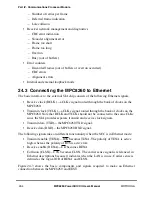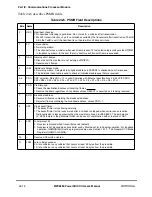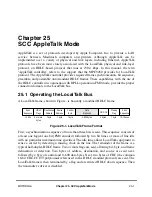
MOTOROLA
Chapter 24. SCC Ethernet Mode
24-13
Part IV. Communications Processor Module
If the external CAM stores addresses that should be rejected rather than accepted, the use
of REJECT by the CAM should be logically inverted.
24.11 Hash Table Algorithm
Individual and group hash Þltering operate using certain processes. The Ethernet controller
maps any 48-bit address into one of 64 bins, each represented by a bit stored in GADDR
x
or IADDR
x
. When a
SET
GROUP
ADDRESS
command is executed, the Ethernet controller
maps the selected 48-bit address into one of the 64 bits by passing the 48-bit address
through the on-chip 32-bit CRC generator and selecting 6 bits of the CRC-encoded result
to generate a number between 1 and 64. Bits 31Ð30 of the CRC result select one of the
GADDRs or IADDRs; bits 29Ð26 of the CRC result indicate the bit in that register.
When the Ethernet controller receives a frame, the same process is used. If the CRC
generator selects a bit that is set in the group/individual hash table, the frame is accepted.
Otherwise, it is rejected. So, if eight group addresses are stored in the hash table and
random group addresses are received, the hash table prevents roughly 56/64 (87.5%) of the
group address frames from reaching memory. Frames that reach memory must be further
Þltered by the processor to determine if they contain one of the eight preferred addresses.
Better performance is achieved by using the group and individual hash tables
simultaneously. For instance, if eight group and eight physical addresses are stored in their
respective hash tables, 87.5% of all frames are prevented from reaching memory. The
effectiveness of the hash table declines as the number of addresses increases. For instance,
with 128 addresses stored in a 64-bin hash table, the vast majority of the hash table bits are
set, thus preventing a small fraction of the frames from reaching memory.
Hash tables cannot be used to reject frames that match a set of entered addresses because
unintended addresses are mapped to the same bit in the hash table.
24.12 Interpacket Gap Time
The receiver receives back-to-back frames with a minimum interpacket spacing of 9.6 µs.
In addition, after the backoff algorithm, the transmitter waits for carrier sense to be negated
before resending the frame. Retransmission begins 9.6 µs after carrier sense is negated if it
stays negated for at least 6.4 µs.
24.13 Handling Collisions
If a collision occurs as a frame is being sent, the Ethernet controller continues sending for
at least 32 bit times, thus sending a JAM pattern of 32 ones. If a collision occurs during the
preamble sequence, the JAM pattern is sent at the end of the sequence.
If a collision occurs within 64 byte times, the retry process is initiated. The transmitter waits
a random number of slot times (512 bit times or 52 µs). If a collision occurs after 64 byte
times, no retransmission is performed and the buffer is closed with an LC error indication.
Содержание MPC8260 PowerQUICC II
Страница 1: ...MPC8260UM D 4 1999 Rev 0 MPC8260 PowerQUICC II UserÕs Manual ª ª ...
Страница 32: ...xxxii MPC8260 PowerQUICC II UserÕs Manual MOTOROLA CONTENTS Paragraph Number Title Page Number ...
Страница 66: ...lxvi MPC8260 PowerQUICC II UserÕs Manual MOTOROLA ...
Страница 88: ...1 18 MPC8260 PowerQUICC II UserÕs Manual MOTOROLA Part I Overview ...
Страница 120: ...2 32 MPC8260 PowerQUICC II UserÕs Manual MOTOROLA Part I Overview ...
Страница 138: ...Part II iv MPC8260 PowerQUICC II UserÕs Manual MOTOROLA Part II Configuration and Reset ...
Страница 184: ...4 46 MPC8260 PowerQUICC II UserÕs Manual MOTOROLA Part II ConÞguration and Reset ...
Страница 202: ...Part III vi MPC8260 PowerQUICC II UserÕs Manual MOTOROLA Part III The Hardware Interface ...
Страница 266: ...8 34 MPC8260 PowerQUICC II UserÕs Manual MOTOROLA Part III The Hardware Interface ...
Страница 382: ...10 106 MPC8260 PowerQUICC II UserÕs Manual MOTOROLA Part III The Hardware Interface ...
Страница 392: ...11 10 MPC8260 PowerQUICC II UserÕs Manual MOTOROLA Part III The Hardware Interface ...
Страница 430: ...Part IV viii MOTOROLA Part IV Communications Processor Module ...
Страница 490: ...14 36 MPC8260 PowerQUICC II UserÕs Manual MOTOROLA Part IV Communications Processor Module ...
Страница 524: ...17 10 MPC8260 PowerQUICC II UserÕs Manual MOTOROLA Part IV Communications Processor Module ...
Страница 556: ...18 32 MPC8260 PowerQUICC II UserÕs Manual MOTOROLA Part IV Communications Processor Module ...
Страница 584: ...19 28 MPC8260 PowerQUICC II UserÕs Manual MOTOROLA Part IV Communications Processor Module ...
Страница 632: ...21 24 MPC8260 PowerQUICC II UserÕs Manual MOTOROLA Part IV Communications Processor Module ...
Страница 652: ...22 20 MPC8260 PowerQUICC II UserÕs Manual MOTOROLA Part IV Communications Processor Module ...
Страница 668: ...23 16 MPC8260 PowerQUICC II UserÕs Manual MOTOROLA Part IV Communications Processor Module ...
Страница 758: ...27 28 MPC8260 PowerQUICC II UserÕs Manual MOTOROLA Part IV Communications Processor Module ...
Страница 780: ...28 22 MPC8260 PowerQUICC II UserÕs Manual MOTOROLA Part IV Communications Processor Module ...
Страница 874: ...29 94 MPC8260 PowerQUICC II UserÕs Manual MOTOROLA Part IV Communications Processor Module ...
Страница 920: ...31 18 MPC8260 PowerQUICC II UserÕs Manual MOTOROLA Part IV Communications Processor Module ...
Страница 980: ...A 4 MPC8260 PowerQUICC II UserÕs Manual MOTOROLA Appendixes ...
Страница 1002: ...Index 22 MPC8260 PowerQUICC II UserÕs Manual MOTOROLA INDEX ...
Страница 1006: ......














































